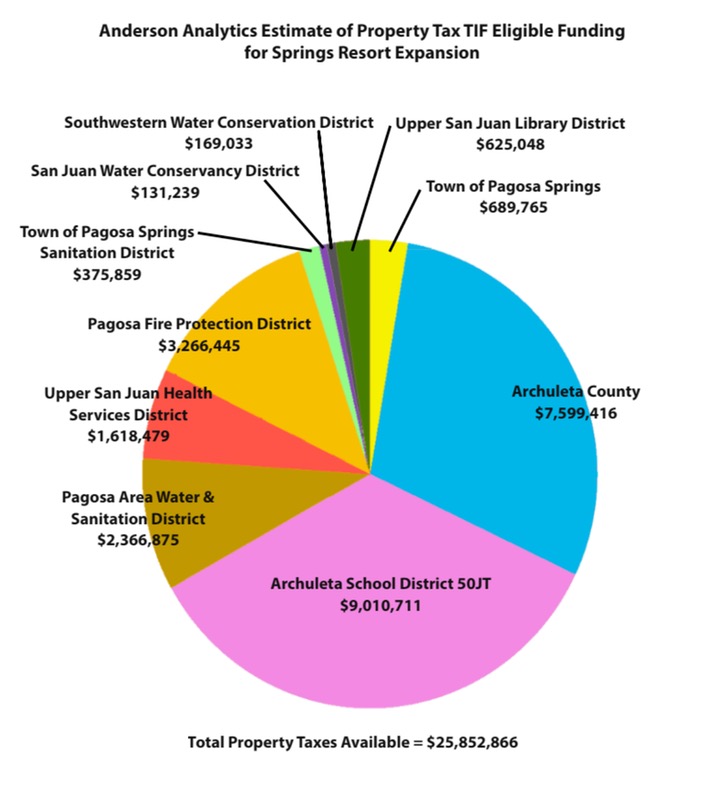The meeting at the Pagosa Springs Town Hall on the evening of Monday, November 25 was rather unique in my experience — an experience that includes, among other things, attendance at hundreds of public meetings as a reporter, and as a citizen activist.
15 people sat around a large table, discussing the Town government’s plans to deliver millions of dollars in corporate welfare over the next 25 years to certain developers connected with the Springs Resort, possibly using a Tax Increment Financing (TIF) scheme… and more particularly, discussing the composition of an Urban Renewal Authority board that would make decisions about said corporate welfare. The meeting was hosted by Town Manager Andrea Phillips and Mayor Don Volger, who were the only Town government representatives at the table.
All the other people seated at the table were representing various tax-funded districts:
Board chair Greg Schulte represented the Upper San Juan Health Service District, operators of the Pagosa Springs Medical Center.
Fire Chief Randy Larson appeared on behalf of the Pagosa Fire Protection District.
Three people attended from the Pagosa Area Water and Sanitation District: Board chair Jim Smith, District Manager Justin Ramsey and Finance Manager Aaron Burns.
Library Director Meg Wempe and board member Gail Dixon represented the Upper San Juan Library District and the Ruby Sisson Memorial Library.
JR Ford appeared on behalf of the Southwestern Water Conservation District.
School Board Vice President Bruce Dryburgh sat in as representative for the Archuleta School District.
And last but not least, the San Juan Water Conservancy District had fielded four board members: Chair John Porco, Vice Chair Al Pfister, and board members Doug Secrist and Bill Hudson (me).
The meeting was unique, in the sense that I had never seen — in my 15 years of political reporting on public meetings — all of Pagosa’s tax-funded special districts, plus the School District and the Town government, all sitting around the same table, discussing a topic of mutual interest. So although I’ve written critically about the Springs Resort’s proposed corporate welfare scheme on 27 vacant acres adjacent to their resort, I can still appreciate the idea that it’s generally healthy for local government entities to talk with one another. Now and then. Not every day, but at least occasionally.

For several years, the Town Council and the Board of County Commissioners were holding regular monthly meetings, to compare notes and plan mutual projects… but shortly after commissioner Michael Whiting finished his two terms in office, those meetings came to a rather sudden halt, and there seems to be very little public communication now between Town and County leaders.
It might be worth noting that the County was the only tax-funded entity that did not attend the November 25 meeting at Town Hall. Perhaps they weren’t invited? Or maybe they turned down the invitation?
For some reason I am reminded, at this moment, of my granddaughter Simone… who loves nothing better than building a “fort” in the living room. A few dining room chairs arranged near the couch, and some blankets and quilts dragged down from the upstairs bedrooms, can result in a cozy little hideout where Simone can be “all alone” with her dolls, or drawing materials, or compact electronic devices, even while the rest of the household is rushing around like chickens with their heads cut off, trying to accomplish important undertakings.
I’m reminded of this, because it seems like the Archuleta Board of County Commissioners, lately, have built themselves a cozy little fort at the Administration Building on Lewis Street, where they can ignore the larger world around them and focus on their own plans to create enormous public debt without voter approval, building expensive jails and courts and offices — to justify a mostly-abandoned County Courthouse in the center of downtown. I think there’s nothing more exciting to County officials than the thought of spending the public’s money on new debt-funded government buildings.
At any rate, the people sitting around the table represented all of the entities shown in the following pie chart — shared previously — except for the County.

As we see in this chart (which I created based on projections provided to the Town government by the Springs Resort) the tax incentives that might be provided to the Springs Resort developers — sometimes referred to, by news reporters, as “corporate welfare” — could total somewhere in the neighborhood of $26 million over 25 years. That comes to about $1 million a year, for a quarter century. The chart suggests that the largest portion of TIF incentives would be extracted from our public schools, followed by our County government, the Fire Protection District, PAWSD, the Medical Center, and the Library, in that order, with a relatively small amount coming from the Town government.
I did not bring my audio recorder to the joint meeting, so I can’t accurately quote the various participants who spoke that evening, around the large table on November 25. But I will do my best to get across the general thrust of the conversation, which was rather lively.
Town Manager Andrea Phillips welcomed everyone, and explained that the Town Council had recently approved the creation of an Urban Renewal Authority, and as part of that approval process, had defined the Authority’s governing board as consisting of all seven of the elected Town Council members on an 11-member board. (Thus, the Town, which according to my calculations might contribute 3 percent of the TIF revenues over the next 25 year period, would have seven votes on issues coming before the Authority.)
The School Board would be allowed one vote. The County would be allowed one vote. (So then, two votes among the taxpayers who might be providing 65 percent of the TIF money.)
And the six remaining special districts? Ms. Phillips explained that the six district would have to figure out a method whereby one person — with one vote on the Authority board — would be selected, to represent all six districts.
Upper San Juan Health Service District Chair Greg Schulte quickly spoke up, explaining how such a selection process might work, and seemingly endorsing the idea of an 11-member government board where the entities contributing 32 percent of the TIF revenues would have only one vote, and the entity contributing 3 percent would have seven votes.
Some of our readers may recall that Mr. Schulte formerly served as the Town Manager, and also served for several years as Administrator for the Archuleta County Board of County Commissioners. During his term with the County, he helped devise the Certificates of Participation arrangement to create a $15 million debt for a new County jail, after the taxpayers twice voted to reject the proposed jail plan. That is to say, Mr. Schulte is quite familiar with the various ways public money can be spent, and public debt created, without voter approval.
But Mr. Schulte seemed to be the only person, among the 13 district representatives at the table, who was completely at ease with the Town’s plan for assigning seats on the Urban Renewal Authority board…

